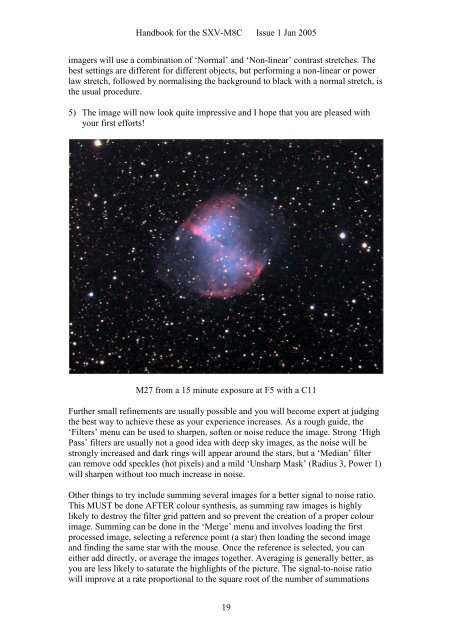SXV-M8C handbook.pdf - Starlight Xpress
SXV-M8C handbook.pdf - Starlight Xpress
SXV-M8C handbook.pdf - Starlight Xpress
- No tags were found...
You also want an ePaper? Increase the reach of your titles
YUMPU automatically turns print PDFs into web optimized ePapers that Google loves.
Handbook for the <strong>SXV</strong>-<strong>M8C</strong> Issue 1 Jan 2005imagers will use a combination of ‘Normal’ and ‘Non-linear’ contrast stretches. Thebest settings are different for different objects, but performing a non-linear or powerlaw stretch, followed by normalising the background to black with a normal stretch, isthe usual procedure.5) The image will now look quite impressive and I hope that you are pleased withyour first efforts!M27 from a 15 minute exposure at F5 with a C11Further small refinements are usually possible and you will become expert at judgingthe best way to achieve these as your experience increases. As a rough guide, the‘Filters’ menu can be used to sharpen, soften or noise reduce the image. Strong ‘HighPass’ filters are usually not a good idea with deep sky images, as the noise will bestrongly increased and dark rings will appear around the stars, but a ‘Median’ filtercan remove odd speckles (hot pixels) and a mild ‘Unsharp Mask’ (Radius 3, Power 1)will sharpen without too much increase in noise.Other things to try include summing several images for a better signal to noise ratio.This MUST be done AFTER colour synthesis, as summing raw images is highlylikely to destroy the filter grid pattern and so prevent the creation of a proper colourimage. Summing can be done in the ‘Merge’ menu and involves loading the firstprocessed image, selecting a reference point (a star) then loading the second imageand finding the same star with the mouse. Once the reference is selected, you caneither add directly, or average the images together. Averaging is generally better, asyou are less likely to saturate the highlights of the picture. The signal-to-noise ratiowill improve at a rate proportional to the square root of the number of summations19
















